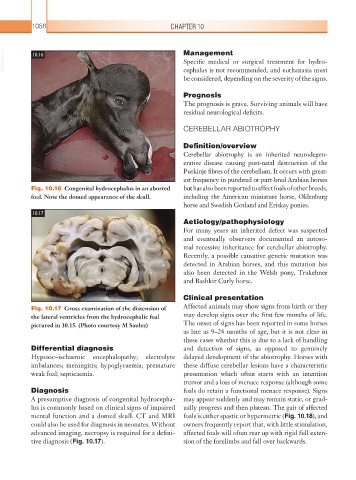Page 1083 - Equine Clinical Medicine, Surgery and Reproduction, 2nd Edition
P. 1083
1058 CHAPTER 10
VetBooks.ir 10.16 Management
Specific medical or surgical treatment for hydro-
cephalus is not recommended, and euthanasia must
be considered, depending on the severity of the signs.
Prognosis
The prognosis is grave. Surviving animals will have
residual neurological deficits.
CEREBELLAR ABIOTROPHY
Definition/overview
Cerebellar abiotrophy is an inherited neurodegen-
erative disease causing post-natal destruction of the
Purkinje fibres of the cerebellum. It occurs with great-
est frequency in purebred or part-bred Arabian horses
Fig. 10.16 Congenital hydrocephalus in an aborted but has also been reported to affect foals of other breeds,
foal. Note the domed appearance of the skull. including the American miniature horse, Oldenburg
horse and Swedish Gotland and Eriskay ponies.
10.17
Aetiology/pathophysiology
For many years an inherited defect was suspected
and eventually observers documented an autoso-
mal recessive inheritance for cerebellar abiotrophy.
Recently, a possible causative genetic mutation was
detected in Arabian horses, and this mutation has
also been detected in the Welsh pony, Trakehner
and Bashkir Curly horse.
Clinical presentation
Fig. 10.17 Gross examination of the distension of Affected animals may show signs from birth or they
the lateral ventricles from the hydrocephalic foal may develop signs over the first few months of life.
pictured in 10.15. (Photo courtesy M Saulez) The onset of signs has been reported in some horses
as late as 9–24 months of age, but it is not clear in
these cases whether this is due to a lack of handling
Differential diagnosis and detection of signs, as opposed to genuinely
Hypoxic–ischaemic encephalopathy; electrolyte delayed development of the abiotrophy. Horses with
imbalances; meningitis; hypoglycaemia; premature these diffuse cerebellar lesions have a characteristic
weak foal; septicaemia. presentation which often starts with an intention
tremor and a loss of menace response (although some
Diagnosis foals do retain a functional menace response). Signs
A presumptive diagnosis of congenital hydrocepha- may appear suddenly and may remain static, or grad-
lus is commonly based on clinical signs of impaired ually progress and then plateau. The gait of affected
mental function and a domed skull. CT and MRI foals is either spastic or hypermetric (Fig. 10.18), and
could also be used for diagnosis in neonates. Without owners frequently report that, with little stimulation,
advanced imaging, necropsy is required for a defini- affected foals will often rear up with rigid full exten-
tive diagnosis (Fig. 10.17). sion of the forelimbs and fall over backwards.

